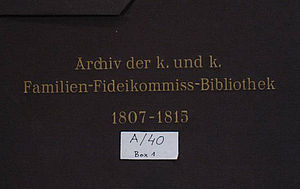The Familien-Fideikommissbibliothek of the House of Habsburg-Lorraine

The Familien-Fideikommissbibliothek of the House of Habsburg-Lorraine family comprises about 116,000 volumes. It includes works about literature, history, technology, natural sciences, geography and philosophy and covers the main political, social and cultural events from the Late Enlightenment period to the end of the monarchy. In addition to books, manuscripts, sketches, printed graphics and paintings, it also includes photographs, maps, dedications to the emperor and » Files and documents about the imperial family.
Most of the contents of the library can be found in our » Catalogue. In a current project at the Austrian National Library, the works are being fully catalogued and will also be available in digitised versions in future. History
- 1784: One of the later emperors, Francis I, began to collect books and portraits in Vienna, starting with a handful but soon accumulating a considerable library.
- 1835: In his will, Francis I instructed that his private library should in future be an indivisible and inalienable patrimony (Fideikommiss) which would always be administered by the first-born male descendant.
- 1878: Emperor Franz Joseph I merged the Fideikomissbibliothek with his own private library and that of Emperor Ferdinand I to form the Familien-Fideikomissbibliothek.
- 1921: The Habsburg-Lorraine Familien-Fideikomissbibliothek was incorporated in the newly founded National Library of the Republic of Austria.
- 2010: A research team began to review the history of the collections as part of two projects funded by the Austrian Science Fund (FWF). The results of the first project, now completed and covering the period up to 1835, are already available in the form of a » Publication.
Aim of the research projects
The Austrian National Library has set itself the goal of researching the history of the library's collections. The basic research is now being carried out for the second FWF project, covering the period from 1835–1921. The change in the library's role that the project is looking at took place in several stages: from a unique private collection to an Fideikommissbibliothek, later becoming a memorial to the monarchy and finally becoming part of the nation's cultural heritage in the republican era. We would like to give new impetus to the story of Austria's princely and national libraries by studying their place in the national identity and collective memory.
Themes of the research projects
- History and science of the library
- History of the Habsburg monarchy and the imperial house
- Art and cultural history
Our research methods include
- Media science
- Analysis of historical sources
Have we made you curious? You can find more information about the results of the project on the » Website for the FWF research project.
